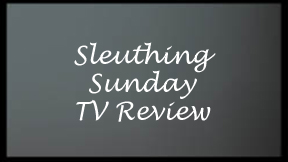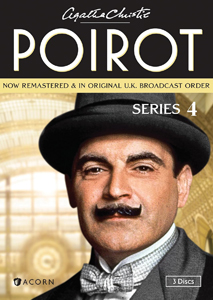After three seasons of adapting short stories (with the exceptions of Season 2’s “Peril at End House” and Season 3’s “The Mysterious Affair at Styles”), “Agatha Christie’s Poirot” takes it easier in Season 4 (1992, ITV) by merely doing three double-length episodes adapting novels.
I don’t know the reason for the choice; perhaps Pauline Moran (as Miss Lemon, who sits out this season) was not available or Hugh Fraser (as Hastings, who appears only in “The ABC Murders”) had limited availability. (Fortunately, Philip Jackson’s Japp pounds the pavement in all three episodes.)
I can guess about the choice of “ABC Murders,” “Death in the Clouds” and “One, Two, Buckle My Shoe”: They had not previously been adapted, with the exception of the former, which was bizarrely presented as a comedy in 1965’s “The Alphabet Murders.” So this marks the first serious adaptation.

“Agatha Christie’s Poirot” Season 4 (1992)
ITV, three episodes
Writers: Clive Exton, William Humble
Stars: David Suchet, Philip Jackson, Hugh Fraser
Broadly speaking, “Poirot” left the previously adapted works for later in the game, a tactic also employed by “Agatha Christie’s Marple,” which wrapped in 1992. This was partially to give viewers the freshest possible tales, partially due to adaptation rights, and partially because – as with all TV – the producers can’t know for sure they’ll be allowed to see any plans to competition.
Here is how I rank the three Season 4 episodes, along with a link to my review of the novel. (SPOILERS FOLLOW.)
1. “Death in the Clouds” (episode 2, written by William Humble)
This marks Humble’s only “Poirot” work, and I must humbly say it’s one of the best episodes up to this point. In rejiggering Christie’s structure – where Poirot and novice assistant Jane Gray (Sarah Woodward) learn about the suspects after the murder on an airplane – we start with activities in Paris that allow us to meet everyone.
Poirot is vacationing on his own, but the guest stars are enjoying the 1935 French Open, including an accurate portrayal of Brit Fred Perry’s four-set win in the final over Germany’s Gottfried von Cramm. Humble might’ve been inspired by Christie’s “Mystery of the Blue Train” (1928), which does include some tennis and was merely on the “maybe” list for adaptation at this point, since the similar “Plymouth Express” had been adapted. (“Blue Train” would come to the screen in Season 10, though.)
The airplane flight is amusing, with Poirot bundling himself up and trying to survive, only happy when he falls asleep. (Also, we learn Poirot is bored by tennis, which I’m a little disappointed by. I’d hoped he would enjoy the sport’s order and method.)

We meet the disheveled author Daniel Clancy (Roger Heathcott), whose detective character “writes himself”; he’s a prototype for the quirky Ariadne Oliver. Most importantly, stewardess Jane is delightful, with Woodward’s expressive smile indicating that she’s a pleasant person in general, not merely putting on a performance for her passengers. Without Hastings or Miss Lemon, it’s essential that we love watching Jane work with Poirot, and we do.
Novel: “Death in the Clouds” (1935)
2. “The ABC Murders” (1, Clive Exton)
As noted, this was adapted in a best-forgotten 1965 movie. It was tackled again in an extremely dark 2018 miniseries with John Malkovich (!) as Poirot. You’ll notice a running theme as we get into future multi-adapted episodes: David Suchet’s version is the best. Director Andrew Grieve and his team add panache by introducing each segment by zooming in on a letter (A, B, C and D) amid the cityscape.
This is one of Christie’s best portrayals of a character with a mental-health issue. Donald Sumpter does it justice as he shows the troubles of Alexander Bonaparte Cust, who may or may not be the ABC Killer who is sending advance tip-off letters to Poirot.
I can understand the 2018 version’s instinct to go quite dark in exploring twisted lengths the killer goes to — offing several strangers for the sake of distraction, and framing someone who will look guilty due to his psychological problems. But I appreciate how the Suchet version pulls back from grim excesses and maintains a balance. Humor comes from Hastings’ desire to tell his South American hunting story, but no one wants to hear it.
Novel: “The ABC Murders” (1936)
3. “One, Two, Buckle My Shoe” (3, Exton)
Although I rank this last, a tip of the Homburg hat must go to Exton for making the incredibly convoluted, almost-impossible-to-follow Christie novel (also known as “The Patriotic Murders,” my preferred title) into a compelling couple of hours. It’s a relief that Exton practically positions British politician Alistair Blunt (Peter Blythe) as a “Columbo” villain; this story includes so many characters that it’s nice to basically be told whodunit. It’s also nice that the ins and outs are fully revealed in Poirot’s (ironically located) boardroom meeting at the end.
Moving the setting back from World War II to the war-buildup era doesn’t hurt the themes, as Poirot lambasts the villain for putting national political concerns ahead of an individual’s right to not be murdered. I love the novel’s theme much more than its structure, and am happy that Exton includes it in grand fashion.
While he doesn’t streamline the plot and character convolutions (nor would I ask him to), the episode is more watchable than the book is readable. Nice touches include Poirot’s disdain for visiting the dentist, the horror of a corpse’s disfigured face being communicated by observers’ reactions, and another of those “disguised” roles (by Joanna Phillips-Lane as the supposed Mabelle Sainsbury-Seale) that the TV series pulls off remarkably well.
Novel: “One, Two, Buckle My Shoe” (1940)
IMDb Top 250 trivia
- “Poirot” ranks at No. 149 in IMDb’s top 250 with an 8.6 rating.
- Fans like “The ABC Murders” (8.4) the best, followed by “Clouds” (7.8) and “Buckle” (7.7).

